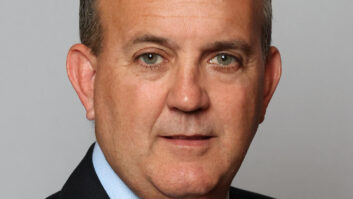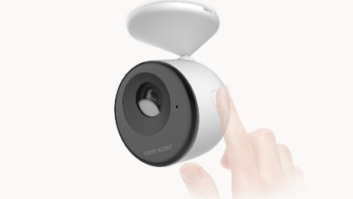Berlin – Just four days after a ballyhooed introduction,
Samsung was forced to remove all traces of its new Galaxy Tab 7.7 from its
booth at the annual IFA show. Sample 7.7s were removed and all signage covered
up.
In some ways, this bit of bad news for Samsung is good news
for the organizers of the annual IFA show, running now through Sept. 7. Reports
of Samsung’s sudden display removal, along with global new product
announcements from Toshiba, Sony, Panasonic, Sharp and Monster Cable, have
pushed IFA into tech headlines.
At the opening the show, executives of Messe Berlin, which
hosts the IFA, and GFU (Gesellschaft für Unterhaltungs-und
Kummunikationselektronik mbH), which runs it were pleased with the additional
attention.
Specifically, the sudden disappearance of the 7.7 from IFA
over the weekend is a result of a Dusseldorf district court granting a motion
from Apple last Friday, part of an ongoing multi-touch patent dispute with
Samsung, to prohibit sales and marketing of Samsung tablets in Germany. Last
month, the same court granted Apple’s petition to temporarily ban the sale of
Samsung’s Galaxy Tab 10.1 in 26 of 27 European Union countries.
A Samsung statement noted: “Samsung respects the
court’s decision … and therefore decided to discontinue the Galaxy Tab 7.7
display at IFA. However, we believe it severely limits consumer choice in
Germany. Samsung will pursue all available measures, including legal options,
to defend its intellectual property rights and ensure its innovative products
remain available to German consumers.”
IFA also presented market research showing that Europe is
now the world’s largest market for consumer electronics.
According to IFA via market research company Gfk, Europe
comprised 28 percent of the global CE market in 2010, with the U.S. capturing
just 21 percent, China 13 percent, South America a growing 12 percent, and
Japan sinking to eight percent.
With the poor global economy, IFA reported global CE sales
have fallen far below 2010 levels, January through April. Executives
optimistically expect business will pick up in the second, however, forecasting
global sales still will end up 6 percent ahead compared to last year.
But IFA organizers found four CE category bright spots.
According to IFA/Gfk, smart-TV sales will rise 53 percent in 2011 to 40 million
units; 3D HDTV sales will burst out 690 percent to 21 million units; tablets
will continue their magical popularity, with sales increasing 258 percent to 55
million units; and smartphones will continue to attract flip-phone switchers
with sales jumping 72 percent to 411 million units.
Nearly every HDTV maker, including LG, Panasonic, Philips,
Samsung, Sharp and Toshiba, heralded their smart-TV offerings. All seem to
bolstering their smart-TV bona fides before Apple announces its own
long-rumored smart TV, reportedly coming this spring.
Here are some of the global CE announcements that were made
at IFA:
Toshiba:
Making perhaps
the biggest splash at IFA prior to Samsung’s Galaxy Tab 7.7 problems, Toshiba
unveiled the first large-screen glasses-free 3D HDTV, the 55ZL2, a 55-inch LCD.
According to Sascha Lange, Toshiba’s managing director for Central Europe, the
55ZL2 — which uses a filter over the screen to replace user-worn glasses —
will start shipping in December, at least in Europe. European executives were
unsure about a release date in the U.S. First reports, however, indicate the
technology lacks the kind of floating-in-space effect seen on both active and
passive 3D sets, and lack sharpness in 3D mode.
The company also laid claim to the lightest and slimmest
10-inch tablet, with its 10.1-inch AT200 and its 13.3-inch Z830 Ultrabook
laptop, respectively, both expected to ship in Q4.
The AT200, which weighs just 1.2 pounds and measures merely
0.3 inches thin, will run Android Honeycomb 3.2 along with Flash 10.3, boasts
micro USB and micro HDMI in/out jacks. The Z830 measures just 0.6 inches at its
thickest point and weighs about 2.5 pounds, yet still has room for an HDMI, a
VGA, a gigabit Ethernet and three USB 3.0 connectors, and can be opened with
one finger.
Samsung:
Along
with the Galaxy 7.7, which actually sports a 7.67-inch screen, Samsung also
bowed the Galaxy Note, a 5.3-inch Android smartphone/tablet that includes an S
Pen stylus for drawing and making handwritten-notes, for some reason unaffected
by Apple’s complaints. Each of the tablets is powered by a 1.4GHz dual core
processor, and each features a Super AMOLED screen. The company declined to say
when or how much, however.
Acer:
Along with
announcing its first super-thin 13.3-inch Ultrabook, the Aspire S3, the
computer company, which had arguably has the most ubiquitous presence at the
show other than Samsung, also noted revenue sank a whopping $2 million in the
first half of 2011 compared to the first half of 2010, from $9.512 billion to
$7.726 billion.
Acer’s good news, relatively speaking, is the
aluminum/magnesium alloy Aspire S3 specifications and technology: it weighs
just a hair more than 3 pounds and is a flat 05 inches thin, it awakes from
normal sleep in just 1.5 seconds and takes just another second to connect to
the Internet. When in deep sleep, its battery can last up to 50 days, up to
seven hours in use. The S3 is due to ship sometime this month, but company
officials were unsure about its U.S. arrival.
Monster Cable:
Five new iPhone-compatible headphone/ear bud lines were introduced, including a
three-model line ($59.95, $69.95, $89.95, shipping now) with replaceable bud
plates called Harajuku Lovers, fronted by Gwen Stefani; non-slip and washable
ear buds for athletes called iSport ($149, October); Earth, Wind &
Fire-inspired Gratitude ear buds ($199, January); fashionista Inspiration
over-the-head phones ($279.95, October) with replaceable headbands ($29.95
each); and, Diesel-branded headphones ($249, November) and ear buds ($149,
January), which will be officially announced in the U.S. on Sept. 13.
Sharp:
While it
announced no new HDTVs, the company displayed the world’s first 8K4K HDTV, an
85-inch LCD with 16 times more resolution than a current 1080p TV. Measuring
6.2 feet by 3.4 feet, the display offered a nearly pixel-invisible resolution
of 7,680 by 4,320. Sharp noted the technology likely would not be
commercialized for another decade, although NHK Japan will be recording the
2012 London Olympics in the format.













